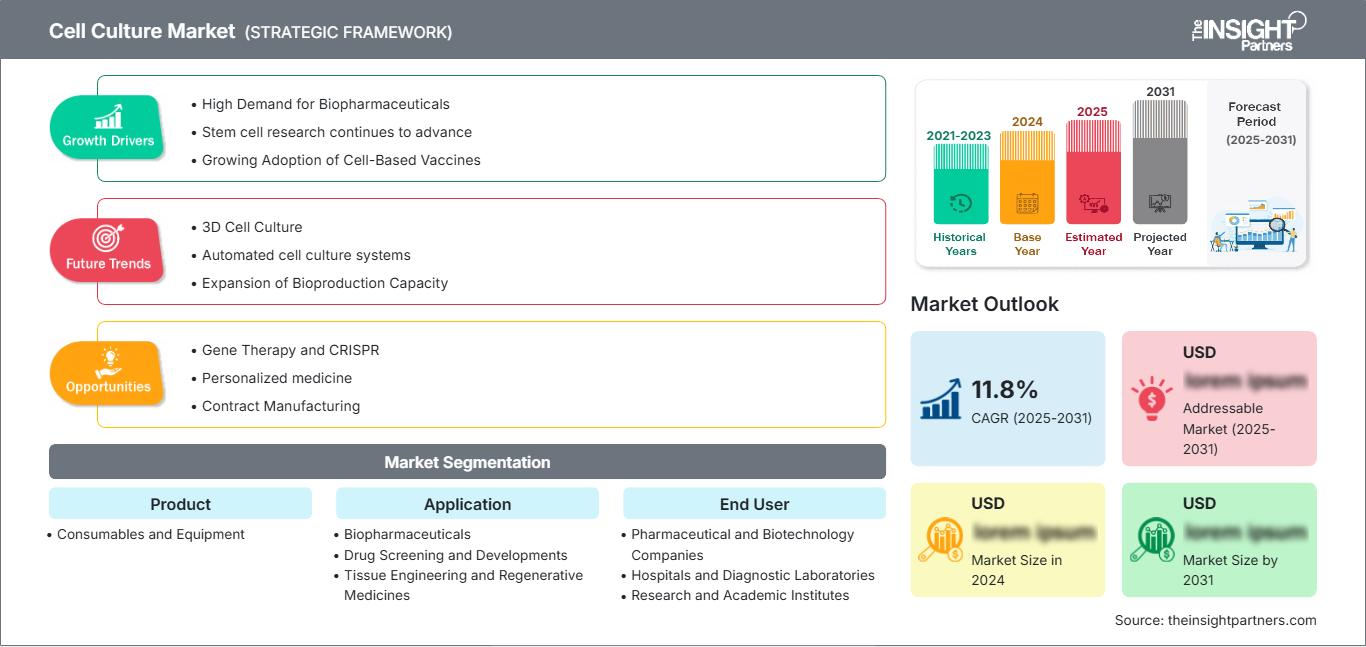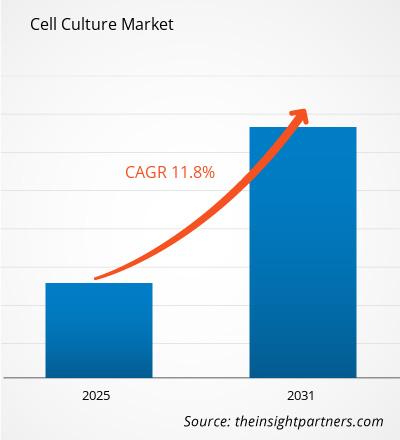Se espera que el tamaño del mercado de cultivo celular alcance los US$ 61.12 mil millones para 2031. Se anticipa que el mercado registre una CAGR del 10,7% durante 2025-2031.
El mercado de cultivos celulares se clasifica por producto en los siguientes subsegmentos: consumibles y equipos. Además, se presenta un análisis basado en la aplicación (biofarmacéuticos, cribado y desarrollo de fármacos, ingeniería tisular y medicina regenerativa, diagnóstico, etc.); y el usuario final (empresas farmacéuticas y biotecnológicas, hospitales y laboratorios de diagnóstico, institutos de investigación y académicos, etc.). El análisis global se desglosa por región y por país principal. La evaluación del mercado se presenta en dólares estadounidenses para el análisis segmentario mencionado.
Propósito del Informe
El informe "Mercado de Cultivos Celulares" de The Insight Partners busca describir el panorama actual y el crecimiento futuro, los principales factores impulsores, los desafíos y las oportunidades. Esto proporcionará información a diversas partes interesadas del negocio, como:
- Proveedores/fabricantes de tecnología: Para comprender la dinámica cambiante del mercado y conocer las oportunidades potenciales de crecimiento, lo que les permitirá tomar decisiones estratégicas informadas.
- Inversores: Realizar un análisis exhaustivo de tendencias respecto a la tasa de crecimiento del mercado, las proyecciones financieras del mercado y las oportunidades que existen en toda la cadena de valor.
- Órganos reguladores: Regular las políticas y las actividades policiales en el mercado con el objetivo de minimizar el abuso, preservar la confianza de los inversores y defender la integridad y estabilidad del mercado.
Segmentación del mercado de cultivos celulares Producto
- Consumibles y equipos
Solicitud
- productos biofarmacéuticos
- Detección y desarrollo de fármacos
- Ingeniería de tejidos y medicinas regenerativas
- Diagnóstico
- Otros
Usuario final
- Empresas farmacéuticas y biotecnológicas
- Hospitales y laboratorios de diagnóstico
- Institutos de investigación y académicos
- Otros
Geografía
- América del norte
- Europa
- Asia-Pacífico
- América del Sur y Central
- Oriente Medio y África
Obtendrá personalización en cualquier informe, sin cargo, incluidas partes de este informe o análisis a nivel de país, paquete de datos de Excel, así como también grandes ofertas y descuentos para empresas emergentes y universidades.
Mercado de cultivos celulares: perspectivas estratégicas

-
Obtenga las principales tendencias clave del mercado de este informe.Esta muestra GRATUITA incluirá análisis de datos, desde tendencias del mercado hasta estimaciones y pronósticos.
Factores que impulsan el crecimiento del mercado de cultivos celulares
- Alta demanda de productos biofarmacéuticos: la demanda de medicamentos biológicos en el tipo de anticuerpos monoclonales y vacunas sigue siendo alta, lo que genera la necesidad de contar con tecnologías de cultivo celular en el desarrollo y fabricación de medicamentos.
- La investigación con células madre sigue avanzando: La investigación con células madre avanza continuamente, y el desarrollo de la investigación sobre células madre, así como la medicina regenerativa, han generado un tremendo impulso en la demanda de productos y métodos de cultivo celular.
- Creciente adopción de vacunas celulares: La adopción de vacunas celulares ha aumentado, especialmente durante la pandemia de COVID-19. Con este aumento, también ha aumentado la demanda de tecnologías de cultivo celular en la formulación de vacunas.
Tendencias futuras del mercado de cultivos celulares
- Cultivo celular en 3D: dado que se asemejan con mayor precisión a los entornos in vivo que los cultivos 2D estándar, el uso de sistemas de cultivo celular en 3D se ha vuelto cada vez más popular hoy en día, ya que también parecen más predictivos en el descubrimiento de fármacos y las pruebas de toxicidad.
- Sistemas automatizados de cultivo celular: La creciente tendencia hacia la automatización, que significa alimentación, recolección y monitoreo automatizados de células, ha hecho que el proceso de cultivo celular sea más eficiente y reproducible.
- Ampliación de la capacidad de bioproducción: ampliar la capacidad de bioproducción debido a la creciente demanda de productos biológicos junto con la creciente dependencia de sistemas de cultivo celular escalables para producir productos biológicos de alta calidad.
Oportunidades de mercado en cultivos celulares
- Terapia genética y CRISPR: Las terapias genéticas y la edición genética con tecnologías como CRISPR abrirán puertas para que las tecnologías de cultivo celular desempeñen papeles clave en la mayoría de los estudios de investigación y desarrollo.
- Medicina personalizada: Los sistemas de cultivo celular serán muy importantes en el desarrollo de tratamientos específicos para cada paciente, especialmente en la investigación del cáncer y en la inmunoterapia con el desarrollo de la medicina personalizada.
- Fabricación por contrato: la demanda de productos biológicos basados en cultivos celulares presenta una oportunidad para que las empresas ofrezcan servicios de fabricación por contrato, especialmente en el creciente mercado de biosimilares.
Perspectivas regionales del mercado de cultivos celulares
Los analistas de The Insight Partners han explicado detalladamente las tendencias regionales y los factores que influyen en el mercado de cultivos celulares durante el período de pronóstico. Esta sección también analiza los segmentos y la geografía del mercado de cultivos celulares en América del Norte, Europa, Asia Pacífico, Oriente Medio y África, y América del Sur y Central.
Alcance del informe de mercado de cultivos celulares
| Atributo del informe | Detalles |
|---|---|
| Tamaño del mercado en 2024 | XX mil millones de dólares estadounidenses |
| Tamaño del mercado en 2031 | 61.120 millones de dólares estadounidenses |
| CAGR global (2025-2031) | 10,7% |
| Datos históricos | 2021-2023 |
| Período de pronóstico | 2025-2031 |
| Segmentos cubiertos |
Por producto
|
| Regiones y países cubiertos |
América del norte
|
| Líderes del mercado y perfiles de empresas clave |
|
Densidad de actores del mercado de cultivos celulares: comprensión de su impacto en la dinámica empresarial
El mercado de cultivos celulares está creciendo rápidamente, impulsado por la creciente demanda del usuario final debido a factores como la evolución de las preferencias de los consumidores, los avances tecnológicos y un mayor conocimiento de los beneficios del producto. A medida que aumenta la demanda, las empresas amplían su oferta, innovan para satisfacer las necesidades de los consumidores y aprovechan las tendencias emergentes, lo que impulsa aún más el crecimiento del mercado.

- Obtenga una descripción general de los principales actores clave del mercado de cultivos celulares
Puntos clave de venta
- Cobertura integral: el informe cubre exhaustivamente el análisis de productos, servicios, tipos y usuarios finales del mercado de cultivo celular, proporcionando un panorama holístico.
- Análisis de expertos: el informe se compila con base en el conocimiento profundo de expertos y analistas de la industria.
- Información actualizada: El informe asegura relevancia comercial debido a su cobertura de información reciente y tendencias de datos.
- Opciones de personalización: este informe se puede personalizar para satisfacer los requisitos específicos del cliente y adaptarse adecuadamente a las estrategias comerciales.
Por lo tanto, el informe de investigación sobre el mercado de cultivos celulares puede ayudar a descifrar y comprender el panorama de la industria y sus perspectivas de crecimiento. Si bien existen algunas preocupaciones válidas, las ventajas generales de este informe suelen superar las desventajas.
- Análisis histórico (2 años), año base, pronóstico (7 años) con CAGR
- Análisis PEST y FODA
- Tamaño del mercado, valor/volumen: global, regional y nacional
- Industria y panorama competitivo
- Conjunto de datos de Excel
Informes recientes
Informes relacionados
Testimonios
Razón para comprar
- Toma de decisiones informada
- Comprensión de la dinámica del mercado
- Análisis competitivo
- Información sobre clientes
- Pronósticos del mercado
- Mitigación de riesgos
- Planificación estratégica
- Justificación de la inversión
- Identificación de mercados emergentes
- Mejora de las estrategias de marketing
- Impulso de la eficiencia operativa
- Alineación con las tendencias regulatorias






















 Obtenga una muestra gratuita para - Mercado de cultivos celulares
Obtenga una muestra gratuita para - Mercado de cultivos celulares